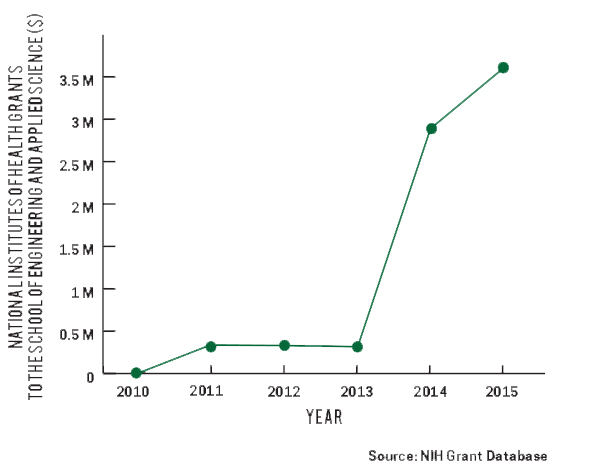GW’s engineering school is upping its efforts to get more federal grants.
Researchers from the School of Engineering and Applied Science have received more than $7 million from the National Institutes of Health since 2010, when they received no funding from the organization. Researchers who earned the grants said officials in the engineering schools have encouraged the faculty to apply for the grants, and have provided more support for researchers aiming to land large grants.
The amount of NIH funding has increased each year since 2010, peaking at $3.6 million last fiscal year. In fiscal year 2014, SEAS received about $3 million in grants.
University spokeswoman Emily Grebenstein said in an email that SEAS faculty had seen an overall increase in grant applications.
“In the past several years, there has been an increase in both the number of federal proposals and all sponsored project proposals submitted by SEAS faculty,” Grebenstein said.
Zhenyu Li, an assistant professor of engineering and applied science, received more than $2 million from NIH last month to develop wearable and handheld sensors for studying asthma in children and young adults. Li said in an email that with the NIH funding, he and his team plan to recruit two research assistants who will help develop the proposed sensors.
“The resources and personnel needed to develop the sensors are significant, which wouldn’t have been available to us without this funding,” Li said.
Li said staff in SEAS and the University’s research office helped him to prepare his proposal by drafting and revising his budget and other paperwork, making sure he was complying with NIH requirements and keeping him on schedule.
David Dolling, the dean of the School of Engineering and Applied Science, said in an email that over the past seven years, SEAS has hired more than 40 new faculty members from top engineering and computer science programs.
“Talented faculty are the key to strengthening research programs,” Dolling said. “Once they are on board, our established SEAS faculty work as mentors to help them get their research programs up and running.”
Last year, to try and generate more research, the University began to give back to schools 27 percent of the money from research that qualifies for a federal funding bonus.
According to a University release, GW received nine research grants worth more than $500,000 each from federal agencies this fall, including one in the School of Engineering and Applied Science.
David Broniatowski, an assistant professor of engineering management and systems engineering, received an NIH grant this year to address the challenges social media data pose for public health officials and plans to compare existing survey data to social media data about influenza vaccination.
Broniatowski said SEAS and research officials were both helpful to him in the grant proposal process.
“In general, SEAS has been very supportive of faculty who choose to pursue opportunities that are consistent with their research objectives,” Broniatowski said. “In that way, I feel like SEAS has done a great job in creating a healthy environment for good scholarship.”







